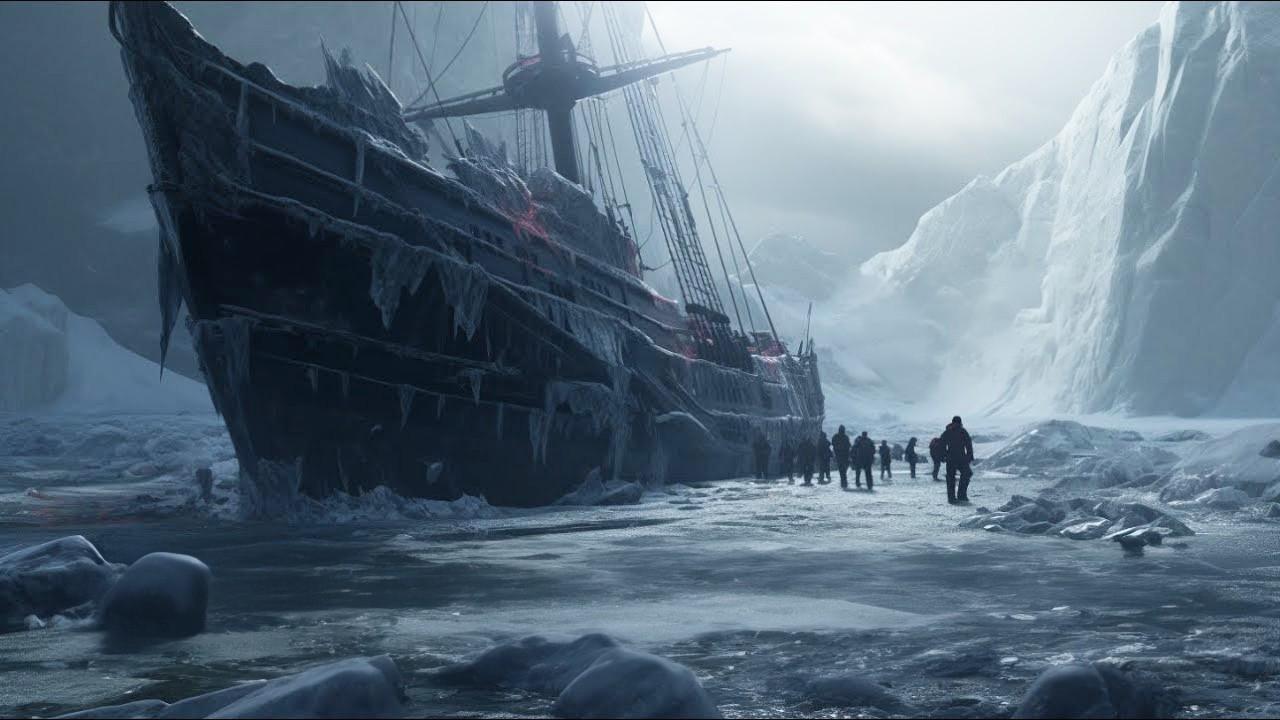
Imagine being part of an elite team on a mission to uncover teh secrets of the Northwest Passage, a fabled water route that has captivated explorers for centuries, only to vanish into thin air, leaving behind a trail of unanswered questions and a mystery that has haunted historians for over 170 years. On May 18, 1845, the British Royal Navy’s most experienced explorer, Sir John Franklin, set sail on a doomed voyage that would become one of the most infamous maritime disasters in history. As we dive into the story of the Franklin Expedition, you’ll discover a tale of hubris, tragedy, and an enduring enigma that continues to fascinate us to this day. The story begins in the mid-19th century, when the British Empire was at the height of its power and influence. The Royal Navy, in particular, was keen to chart the Northwest Passage, a mythical route that promised to connect the Atlantic to the Pacific Ocean, granting Britain a meaningful advantage in global trade and navigation. Sir John Franklin, a seasoned explorer with years of experience in the Arctic, was handpicked to lead this enterprising endeavor. with a crew of 129 men and two sturdy ships, the HMS Erebus and HMS terror, Franklin was confident that he could conquer the treacherous waters and ice fields that had foiled previous expeditions.
As the expedition set sail from Greenhithe, England, it was met with fanfare and optimism, with many believing that Franklin would finally unlock the secrets of the Northwest Passage. The initial months were marked by a series of promising encounters with the ice. The crew successfully navigated through Baffin Bay and into the treacherous waters of Lancaster Sound, where they encountered massive icebergs and harsh weather conditions. Despite these challenges, Franklin’s team persevered, charting new territories and making crucial observations about the Arctic environment. Though, as they ventured deeper into the unknown, the crew began to face increasingly dire circumstances. The ships became trapped in the ice near King William Island, and the crew was forced to abandon ship, taking with them limited supplies and equipment. It’s hear that the story takes a dark and tragic turn. As the crew struggled to survive in the harsh Arctic environment,they faced unimaginable hardships. With limited food and supplies, the men were forced to endure grueling marches across the frozen tundra, battling against temperatures as low as -40°C. the Inuit, who had lived in harmony with the Arctic for centuries, would later report finding evidence of the crew’s desperate attempts to survive, including the remains of makeshift camps and the bodies of men who had succumbed to the extreme conditions. The Franklin Expedition’s fate was sealed, and as the months passed, the crew’s situation grew increasingly dire.
Some of the key events and milestones of the Franklin Expedition include:
departure from England: the Franklin expedition set sail from Greenhithe, England on May 18, 1845.
Navigation through Baffin bay: The crew successfully navigated through Baffin Bay and into the treacherous waters of Lancaster Sound.
Ships become trapped in ice: The HMS Erebus and HMS Terror became trapped in the ice near King William Island.
Crew abandon ship: The crew was forced to abandon ship, taking with them limited supplies and equipment.
The last recorded sighting of the expedition was in july 1845, when a whaling ship spotted the HMS Erebus and HMS Terror anchored to an iceberg off the coast of Baffin Island. As news of the expedition’s disappearance reached Britain, a massive search effort was launched, with multiple rescue missions scouring the Arctic for any sign of Franklin and his crew.The search parties found tantalizing clues, including a cryptic message left behind by Franklin, which hinted at the expedition’s tragic fate. The message, dated April 1848, revealed that the ships had been trapped in the ice for over a year and that Franklin had died, along with several other crew members. The remaining crew, now lead by francis Crozier, had abandoned ship and were attempting to trek to safety. However, it would later become clear that this desperate bid for survival ultimately ended in catastrophe.In recent years, advances in technology and research have shed new light on the expedition’s tragic fate. In 2014,a Canadian expedition located the wreck of the HMS Erebus,and two years later,the HMS Terror was found,remarkably well-preserved,in a fjord off King William Island. These discoveries have allowed researchers to piece together the final days of the Franklin Expedition, revealing a story of bravery, tragedy, and the unforgiving power of the arctic environment. Some of the possible reasons for the expedition’s failure include:
Hubris and overconfidence: Franklin’s team may have underestimated the challenges of navigating the Northwest Passage.
Lead poisoning: The crew may have suffered from lead poisoning due to the canned food that was a staple of their diet.
* Insufficient supplies: The expedition may have been poorly provisioned, leading to a shortage of food and supplies.
The mystery surrounding the Franklin Expedition’s disappearance sparked a wave of public captivation, with many theories emerging about the crew’s fate. The Franklin Expedition’s legacy extends far beyond the tragedy itself,serving as a cautionary tale about the dangers of hubris and the importance of understanding and respecting the natural world. Today, the story of the Franklin Expedition remains an enduring enigma, a testament to the power of human curiosity and the importance of exploring the unknown.
#FranklinExpedition #ArcticMystery #MaritimeHistory #NorthwestPassage #UnsolvedMysteries #HistoricalEnigma #ExplorersOfThePast #TheInfographicsShow #DidYouKnow #TrueStory #HistoryBuff #GlobalFigures #MysteriousPhenomena #LostAtSea #RoyalNavy #SirJohnFranklin
<img class="bimage_class" src="https://campusstore.co.za/wp-content/uploads/2025/04/723ae3.jpg0de6.jpg" alt="the Cursed Expedition: Unraveling the Mysterious Disappearance of the franklin Expedition
Imagine being part of an elite team on a mission to uncover the secrets of the Northwest Passage, a fabled water route that has captivated explorers for centuries, only to vanish into thin air, leaving behind a trail of unanswered questions and a mystery that has haunted historians for over 170 years.On May 18, 1845, the British Royal Navy’s most experienced explorer, Sir John Franklin, set sail on a doomed voyage that would become one of the most infamous maritime disasters in history. As we dive into the story of the Franklin Expedition, you’ll discover a tale of hubris, tragedy, and an enduring enigma that continues to fascinate us to this day.The story begins in the mid-19th century, when the British Empire was at the height of its power and influence. The royal Navy, in particular, was keen to chart the Northwest Passage, a mythical route that promised to connect the Atlantic to the Pacific Ocean, granting Britain a significant advantage in global trade and navigation. sir John Franklin, a seasoned explorer with years of experience in the Arctic, was handpicked to lead this ambitious endeavor. With a crew of 129 men and two sturdy ships, the HMS Erebus and HMS Terror, Franklin was confident that he could conquer the treacherous waters and ice fields that had foiled previous expeditions.As the expedition set sail from Greenhithe, England, it was met with fanfare and optimism, with many believing that Franklin would finally unlock the secrets of the Northwest Passage.
As we follow the Franklin Expedition’s journey, we find that the initial months were marked by a series of promising encounters with the ice. The crew successfully navigated through Baffin Bay and into the treacherous waters of Lancaster Sound, where they encountered massive icebergs and harsh weather conditions. Despite these challenges, Franklin’s team persevered, charting new territories and making crucial observations about the Arctic environment. However,as they ventured deeper into the unknown,the crew began to face increasingly dire circumstances. The ships became trapped in the ice near King William island, and the crew was forced to abandon ship, taking with them limited supplies and equipment. It’s here that the story takes a dark and tragic turn.
As the crew struggled to survive in the harsh Arctic environment, they faced unimaginable hardships. With limited food and supplies, the men were forced to endure grueling marches across the frozen tundra, battling against temperatures as low as -40°C. The Inuit, who had lived in harmony with the Arctic for centuries, would later report finding evidence of the crew’s desperate attempts to survive, including the remains of makeshift camps and the bodies of men who had succumbed to the extreme conditions. The Franklin Expedition’s fate was sealed, and as the months passed, the crew’s situation grew increasingly dire. The last recorded sighting of the expedition was in July 1845, when a whaling ship spotted the HMS Erebus and HMS Terror anchored to an iceberg off the coast of Baffin Island.
As news of the expedition’s disappearance reached Britain,a massive search effort was launched,with multiple rescue missions scouring the Arctic for any sign of Franklin and his crew. The search parties found tantalizing clues, including a cryptic message left behind by Franklin, which hinted at the expedition’s tragic fate. The message, dated April 1848, revealed that the ships had been trapped in the ice for over a year and that Franklin had died, along with several other crew members. The remaining crew, now led by Francis Crozier, had abandoned ship and were attempting to trek to safety. Though, it would later become clear that this desperate bid for survival ultimately ended in catastrophe.
The mystery surrounding the Franklin Expedition’s disappearance sparked a wave of public fascination, with many theories emerging about the crew’s fate. Some believed that they had been attacked by the Inuit,while others speculated that they had succumbed to lead poisoning from the canned food that was a staple of their diet. In recent years, advances in technology and research have shed new light on the expedition’s tragic fate. In 2014, a Canadian expedition located the wreck of the HMS Erebus, and two years later, the HMS Terror was found, remarkably well-preserved, in a fjord off King William Island.These discoveries have allowed researchers to piece together the final days of the Franklin Expedition, revealing a story of bravery, tragedy, and the unforgiving power of the Arctic environment.
As we unravel the mystery of the Franklin Expedition,we’re struck by the realization that this tragic event had a profound impact on the history of Arctic exploration. The loss of the expedition led to a significant shift in the way that explorers approached the Arctic, with a newfound respect for the region’s treacherous conditions and the indigenous people who had lived there for centuries. The Franklin Expedition’s legacy extends far beyond the tragedy itself, serving as a cautionary tale about the dangers of hubris and the importance of understanding and respecting the natural world. Today,the story of the Franklin Expedition remains an enduring enigma,a testament to the power of human curiosity and the importance of exploring the unknown.
As we conclude this journey into the mysterious disappearance of the Franklin Expedition, we’re reminded of the countless other mysteries that remain unsolved, waiting to be uncovered by intrepid explorers and curious historians. The story of the Franklin Expedition is a powerful reminder of the importance of perseverance, courage, and the unrelenting pursuit of knowledge. Join the conversation and share your thoughts on this fascinating topic using the following hashtags: #FranklinExpedition #ArcticMystery #MaritimeHistory #NorthwestPassage #UnsolvedMysteries #HistoricalEnigma #ExplorersOfThePast #TheInfographicsShow #DidYouKnow #TrueStory #HistoryBuff #GlobalFigures #MysteriousPhenomena #LostAtSea #RoyalNavy #SirJohnFranklin”>








